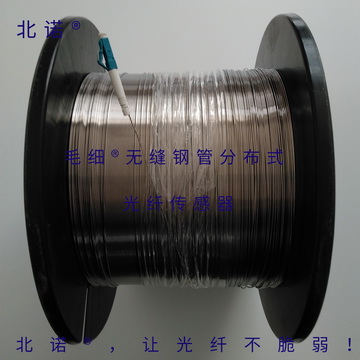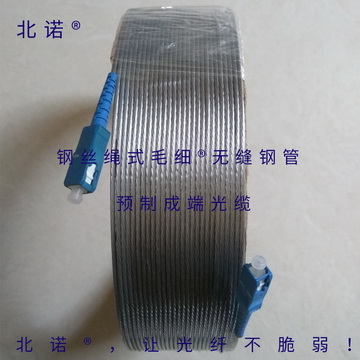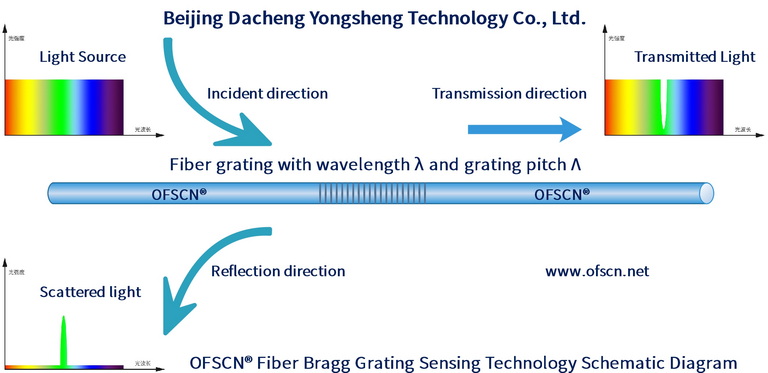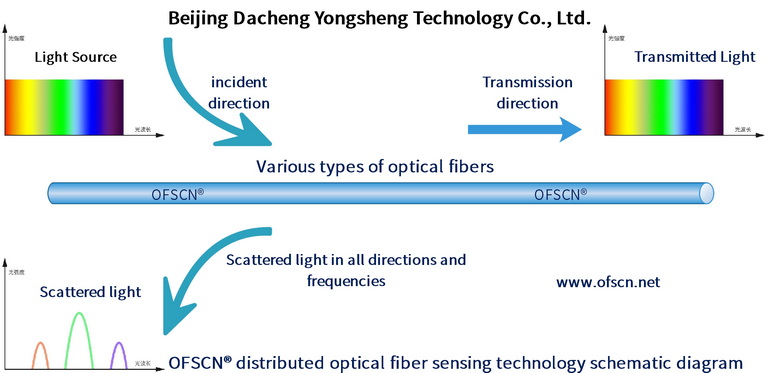This article introduces the principles of distributed optical fiber sensing technology, as well as the concepts of Raman scattering, Rayleigh scattering, and Brillouin scattering. The principles of fiber optic grating sensing technology are also described, and the differences between these two technologies are compared. This lays the foundation for understanding the usage environments and how to choose between distributed optical fiber sensors and fiber optic grating sensors.
Table of Contents:
The principle differences between fiber optic grating sensing technology and distributed optical fiber sensing technology - Video
Differences in appearance between fiber optic grating sensors and distributed optical fiber sensors
Our friends who are familiar with our company know that Dacheng Yongsheng is a company that specializes in fiber optic gratings and fiber optic protection. Our patented products include fiber optic grating sensors, distributed optical fiber sensors, and armored fiber optic jumpers, which are based on seamless stainless steel tube encapsulation technology.
 |
 |
|
Figure 1 |
Figure 2 |
 |
|
|
Figure 3 |
|
3. The principle of fiber optic grating sensors - The principle of fiber optic grating sensing technology
In the field of fiber optic sensing, we produce both fiber optic grating sensors and distributed optical fiber sensors. So what are the differences between these two fiber optic sensing technologies?
Fiber optic grating sensing is a fiber optic sensing technology based on reflected light wave length information. Its sensing unit is the fiber optic grating. Therefore, the physical quantity being tested depends not only on the fiber optic grating demodulator, but also on the fiber optic grating. It is a short-distance point-to-point measurement (single-point or multi-point), even for multi-point fiber optic grating sensors, which are called quasi-distributed or serial, it is still point-to-point measurement. Detection of the corresponding physical quantity can only be done at the point where the fiber optic grating is fabricated. The principle of its sensing can be seen in the following figure:
 |
|
Figure 4 |
The broadband light emitted by the fiber optic grating demodulator enters the fiber optic from left to right. When it passes through the fiber optic grating, it reflects back a narrowband light of a specific wavelength. The wavelength of the narrowband light depends on the grating spacing (grating period) of the fiber optic grating. The mathematical expression is: λ=2nΛ, where λ is the center wavelength of the fiber optic grating, n is the effective refractive index of the core, and Λ is the grating spacing (grating period) of the fiber optic grating. Therefore, the demodulator of the fiber optic grating can demodulate the corresponding physical quantity by detecting the wavelength of the reflected light. The wavelength shift of the reflected light caused by the physical quantity being tested can be detected by the fiber optic grating demodulator.
The grating pitch (grating period) of a fiber Bragg grating (FBG) changes with temperature and external forces, expanding and contracting, lengthening and shortening. After being professionally packaged by OFSCN's seamless steel pipe fiber Bragg grating sensor, the reflected wavelength λ of the fiber Bragg grating sensor corresponds to the three physical quantities of temperature, force, and length. This is the basic principle of fiber Bragg grating sensing technology.
4. The principle of distributed optical fiber sensors - The principle of distributed optical fiber sensing technology
Unlike fiber grating sensing, common distributed fiber optic sensing (DFOS) is a fiber optic sensing technology based on multiple scattering information of fiber optic such as intensity, frequency, and phase, with the sensing unit being the fiber optic. The physical quantity it measures depends not only on the fiber optic but also on the modulation and demodulation equipment and algorithm, and the measured physical quantity is mostly the average value of the physical quantity at the location of any segment of the fiber optic sensor (such as the average temperature within 1 meter range on a 10-kilometer fiber optic). The sensing principle is shown in the figure below:
 |
|
Figure 5 |
Similarly, broadband light emitted from fiber optic sensing equipment enters the fiber optic from left to right. Due to the inherent impurities in the fiber optic, light will scatter. This can be understood as the collision of light particles with some inherent impurities in the fiber optic, resulting in the particles bouncing in various directions, with a higher frequency. These scattered lights are collectively referred to as scattered light. Based on the different frequency characteristics of the scattered light, these scattered light can be classified as Rayleigh scattering, Raman scattering, and Brillouin scattering.
These scattered light signals are usually related to the position, temperature, stress, strain, vibration, and other physical quantities of the fiber optic environment. Therefore, various devices have been developed to measure the physical quantities of the environment in which the DFOS is located by measuring changes in the scattered signals inside the fiber optic.
It should be noted that the scattered signal shown in the lower left corner of the DFOS principle diagram in Figure 5 is Raman scattering and Brillouin scattering, whose frequency, intensity, and incident light are far different. The frequency of Rayleigh scattering is the same as the incident light. The direction of the three types of scattered light is not necessarily opposite, and what is drawn here is only for illustration purposes. Due to the complexity of the DFOS technology involved, we will not elaborate on the details here.
5. Packaging of Distributed Fiber Optic Sensors - Packaging of Fiber Optic Grating Sensors
Whether it is based on fiber grating sensing technology or DFOS technology, they are both sensing technologies based on fiber optic. We all know that fiber optics are very powerful but extremely fragile. Without protection, they are almost unusable. The application environment of fiber optic sensing is even more severe and complex than that of fiber optic communication. Therefore, Beijing Da Cheng Yong Sheng Technology Co., Ltd. has developed a series of products based on seamless stainless steel tube packaging technology, including OFSCN® micro® seamless steel tube series fiber optic grating sensors, DFOS, and armored fiber optic jumpers, which expand the applicable range of fiber optic in harsh environments.
The DFOS of Da Cheng Yong Sheng is a universal product, which is adaptable to various manufacturers' demodulation equipment, including but not limited to various Brillouin scattering (BOTDR, BOTDA, BOFDR, etc.), Rayleigh scattering (OTDR, OFDR), and Raman scattering (FOTDR, FOFDR, ROTDR, ROFDR, etc.) fiber optic sensing systems. In principle, there is no need to match a specific set of equipment.
The following is the difference in principles between distributed fiber sensing technology and fiber grating sensing technology. As we often encounter questions from customers about which type of fiber sensor to choose between OFSCN, we will explain their application environments in detail in the following sections. Please stay tuned.
6. Differences in Application Environments between Fiber Grating Sensing Technology and Distributed Fiber Sensing Technology
For details on the differences in application environments between fiber grating sensing technology and distributed fiber sensing technology, please refer to the following:
Our philosophy is: "OFSCN®, make optical fiber stronger!"
